
- Homepage
- Author
- Aleister Crowley (6)
- Arthur Von Mayer (15)
- Bram Stoker (8)
- Charles Dickens (9)
- Dan Brown (7)
- Dr. Seuss (16)
- Ernest Hemingway (9)
- Frank Herbert (9)
- George Orwell (12)
- Ian Fleming (5)
- J.k. Rowling (43)
- J.r.r. Tolkien (16)
- Kurban Said (5)
- L. Frank Baum (7)
- Margaret Mitchell (8)
- Mark Twain (7)
- Robert Paul Smith (6)
- Rudyard Kipling (9)
- Stephen King (28)
- Unknown (5)
- Other (2197)
- Illustrator
- Arthur Rackham (10)
- Austin Osman Spare (2)
- Black Magic (3)
- Esther Warren (2)
- Garth Williams (2)
- J. R. R. Tolkien (3)
- Jenia Graman (5)
- John Leech (2)
- John Pound (2)
- John Tenniel (3)
- Ken Sugimori (4)
- Marc Chagall (2)
- Mary Grandpre (7)
- Mary Grandpré (2)
- Michael Whelan (4)
- Not Stated (9)
- Sidney Paget (2)
- Thomas Taylor (11)
- Unknown (6)
- Various (6)
- Other (2340)
- Origin
- Publisher
- Alfred A. Knopf (25)
- Bloomsbury (22)
- Chilton (7)
- Doubleday (25)
- Dutton (9)
- Easton Press (13)
- Franklin Library (11)
- G.p. Putnam's Sons (9)
- Grosset & Dunlap (10)
- Harper & Brothers (16)
- Harper & Row (15)
- Harvard Classics (8)
- Jonathan Cape (8)
- Macmillan (19)
- Marvel Comics (10)
- Random House (41)
- Scholastic Press (8)
- Steiger (15)
- The Viking Press (8)
- Viking Press (12)
- Other (2136)
- Subject
- Americana (28)
- Art & Photography (86)
- Children's (104)
- Cooking (8)
- Exploration & Travel (23)
- History (114)
- Illustrated (27)
- Law & Government (7)
- Literature & Fiction (435)
- Men (6)
- Military & War (14)
- Outdoor & Nature (8)
- Philosophy (15)
- Poetry (9)
- Reference (9)
- Science & Medicine (37)
- Science Fiction (5)
- Self-help (10)
- Sports & Recreation (9)
- Vintage Paperbacks (5)
- Other (1468)
- Year Printed
Rare 1655 MERIAN & JONSTON Colored Folio Engraving HISTORIA NATURALIS TAURUS OX
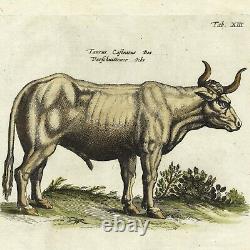
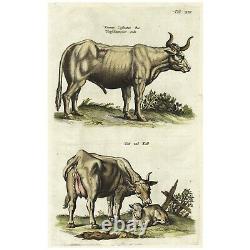
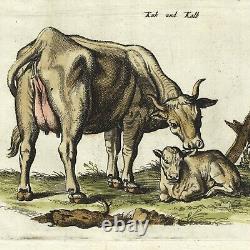
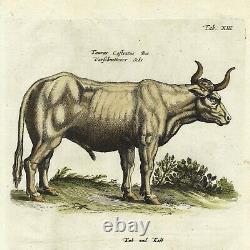
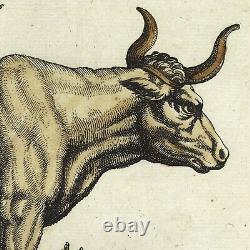
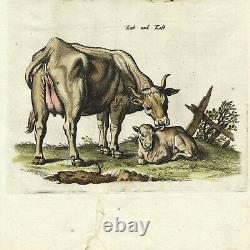
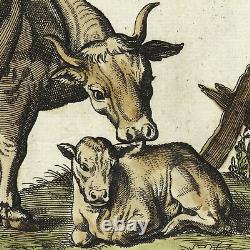
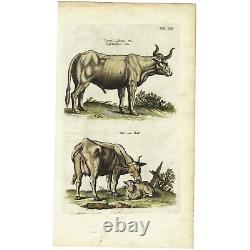
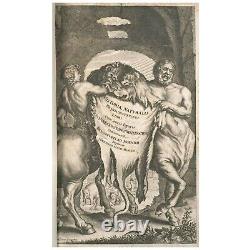


Rare 1655 Hand-Colored Copper-Plate Engraving from. Tab : XIII Taurus Castratus Bos, Kuh und Kalb. In the middle of the 16th century, the Doctor and Renaissance Man, Johnnes Jonston wrote his magnum opus, an encyclopedic overview of the history of animals, which was considered to be the standard work of zoology for a century. For his HISTORIAE NATURALIS, Jonston planned a comprehensive illustrated depiction of the world of animals, plants, and people. Titled in short Historia Naturalis Animalium, it collects numerous descriptions of animals in five books.
Tables with wonderful copperplate engravings by Matthäus Merian the Younger illustrate the zoological work. In the first volume of the work, which arose in the year 1650, Jonston concerns himself with fish and aquatic mammals. This "most broadly disseminated zoological handbook" experienced numerous republications and translations into other languages, still offering a magnificent and often curious glimpse into the world of zoology today. The marvelous illustrations, colorfully illustrated moreover, lend the sophisticated publication its final touches and are surely a reason for the exceptional popularity of the Historia Naturalis across Europe. Volume 5, QUADRUPEDIBUS (Quadrupeds), contained 80 numbered plates, called Tables, of which this plate is Tab.Doctor of Medicine and a well-travelled and prolific writer on natural history, who published numerous works, including " Historiae naturalis " in Frankfurt, Germany, from 1646 to 1662. He authored over fifteen works on nature and medicine. The most famous was this one, Historiae naturalis, about the animal kingdom.
It had these gorgeous engravings by Matthaus Merian. The Younger was the half-brother of Maria Sybilla Merian, who is famous for her magnicent Metamorphosis Insectorum Surinamensium of1705, and the brother of Caspar Merian, who also worked on these volumes. Every part of these prints was made by hand: Hand drawn & engraved on Copper or steel which was hand-mined, smelted & rolled, printed onto handmade cotton rag paper, inked & colored with hand-ground pigments individually by hand, & they were usually hand sewn into handmade leather-bound books. A set of the full volumes of this work.Appears to be in good condition for a centuries-old engraving. The hand-coloring appears to remain sharp & brilliant. Typical age-toning & character for a print this old. Repair at the bottom edge appears to be expertly done.
Please peruse the detailed photos. Printed on light Chain-Lined paper with plate-marks.
These prints are very old & may have minor imperfections expected with age, such as some typical age-toning of the paper, oxidation of the old original watercolors, spots, text-offsetting, artifacts from having been bound into a book & handled as a page in a volume, etc. Please examine the photos & details carefully. Text Page(s): This one doesn't come with text page(s).Please note, the scans of the title page is included for reference, it's not part of this listing... An Ox, also known as a bullock (in British, Australian, and Indian English), is a bovine (Cow, Bull), trained and used as a draft animal. Oxen are used for plowing, for transport (pulling carts, hauling wagons and even riding), for threshing grain by trampling, and for powering machines that grind grain or supply irrigation among other purposes.
Oxen may be also used to skid logs in forests, particularly in low-impact, select-cut logging. Oxen are thought to have first been harnessed and put to work around 4000 BC. The Mighty Aurochs (Bos primigenius) is an extinct cattle species, considered to be the wild ancestor of modern domestic cattle. With a shoulder height of up to 71" in bulls and 61" in cows, it was one of the largest herbivores in the Holocene; it had massive elongated and broad horns that reached 31 in length.
The aurochs was part of the Pleistocene megafauna. It probably evolved in Asia and migrated west and north during warm interglacial periods. The oldest known aurochs fossils found in India and North Africa date to the Middle Pleistocene and in Europe to the Holstein interglacial. As indicated by fossil remains in Northern Europe, it reached Denmark and southern Sweden during the Holocene.
The aurochs declined during the late Holocene due to habitat loss and hunting, and became extinct around the 17th century. Size: 15" x 8-1/2" inches approximately. If you'd like to combine & need more time to choose, please send a message & we'll do our best to oblige.

